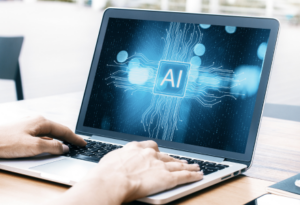INSIDE THE 
NEWS + ADVICE
How to Use AI In Your Cleared Job Search from Resume Writing to Salary Negotiation

Are you ready to uncover the secrets to making job search a breeze with cutting-edge technology? We’re diving into the realm of artificial intelligence (AI) and how it’s revolutionizing the job search game.
Employers are increasingly leveraging AI to streamline their recruitment efforts, and as job seekers, it’s crucial to harness this technology to your advantage too. By incorporating AI tools, you can enhance your resume, cover letters, job fair and interview skills, negotiation tactics, and more!
Read our guide below for comprehensive tips to use AI in your job search, or listen to our recent AI and job search podcast episode featuring insights from our hosts and special guest, Ashley Owens, a recruiter familiar with using AI on both sides of the hiring/job search process.
As we cover some of the various ways to use AI in your job search, keep in mind that the information generated by AI may not always be 100% accurate or ready for immediate use without adding your human touch. It’s a great tool for brainstorming and producing first drafts that you can turn into a polished final product with some adjustments. Let’s take a look at some of the ways you can use AI in your cleared job search:
1. Crafting Resumes with AI
Your cleared resume plays a big role in helping secure interviews that may lead to your dream job. And with AI by your side, you can ensure your resume shines brighter than ever before. Gone are the days of agonizing over every word and fighting through writer’s block. With AI-powered platforms like ChatGPT, you can generate a resume in a matter of seconds.
Simply input your job history, skills, and desired role, and watch as your AI tool transforms this information into polished resume content that showcases your strengths and experiences. This technology can also assist in refining your content to match specific job descriptions, ensuring your resume aligns perfectly with the requirements of each position you apply for.
Follow these simple steps to craft a standout resume that gets noticed with the help of generative AI:
- Enter Your Prompt: Start a new chat by entering something in the prompt field. Provide specific details about the resume you want to create or enhance (you can paste in your existing resume if you don’t want to start from scratch). Be sure to include key information such as your job history, skills, desired role, and any other relevant details. For example, you might input:
- “Revise these bullet points for a resume to make them more concise.”
- “Create a resume for an electrical engineer with [X years of experience] in [specific industry or specialization], highlighting expertise in electrical circuit design, testing, and analysis.”
- Be Specific: The more specific you are in your prompt, the better the results will be. You can specify the industry, job title, and any specific requirements or preferences you have for the resume. For instance:
- “Revise my resume to align with the job description for [specific job title] at [company name]. Ensure my qualifications and experiences are highlighted to match the requirements outlined in the job posting. Focus on emphasizing skills such as [list key skills from the job description] and incorporate any relevant keywords or buzzwords mentioned in the job listing. Aim for a tailored resume that effectively showcases my fit for the position and increases my chances of securing an interview.”
- Review and Revise: Once you’ve entered your prompt, a response will be generated based on the information provided. Review the generated content carefully and make any necessary revisions or adjustments to ensure it aligns with your preferences and goals.
- Repeat As Necessary: If you’re not satisfied with the initial response, don’t hesitate to refine your prompt and try again. AI tools like ChatGPT can generate a variety of responses based on different inputs, so experiment until you find what you’re looking for.
2. Enhancing Cover Letters
Similar to creating and editing your resume, you can leverage AI to craft personalized and impactful cover letters that resonate with hiring managers. Here are some example prompts you can use to generate a tailored cover letter, to help you understand the different ways you can use generative AI:
- Tailoring to the Job Description: “Generate a cover letter for a [specific job title] position at [company name], emphasizing my experience in [relevant skills or qualifications] and aligning with the company’s mission of [mention company mission or values].”
- Highlighting Unique Skills: “Create a cover letter showcasing my expertise in [specific skills or industry knowledge] and how they make me an ideal candidate for the [job title] position at [company name].”
- Expressing Passion for the Industry: “Craft a cover letter that communicates my passion for [industry or field] and how my background aligns with the goals of [company name].”
- Addressing Career Transitions: “Generate a cover letter that explains my career transition from [previous industry or role] to [desired industry or role], highlighting transferable skills and enthusiasm for the [job title] position at [company name].”
- Acknowledging Company Achievements: “Create a cover letter acknowledging [recent achievement or milestone] at [company name] and expressing my interest in contributing to its continued success in the role of [job title].”
3. Streamlining Job Fair Prep
In addition to helping you craft polished resumes and compelling cover letters, AI technology can also assist you in preparing for Cleared Job Fairs and networking events. During these events, it’s essential to be prepared, confident, and able to articulate your skills and experiences effectively. This is where AI can be a game-changer. By leveraging AI-powered platforms, you can:
- Craft Elevator Pitches: Use AI to refine your elevator pitch, a brief and compelling summary of your background and career objectives, to engage recruiters and make a memorable impression in a short amount of time.
- Research Participating Companies: Utilize AI to gather insights about the companies attending the job fair. This knowledge will enable you to ask informed questions and demonstrate your interest in their organization.
- Prepare Questions for Recruiters: Generate a list of tailored introductions and thoughtful questions to ask recruiters at the event, showcasing your curiosity, enthusiasm, and understanding of their company and industry.
- This is particularly useful for virtual job fairs because you can save your introductions and questions in a document and later copy and paste them into the chat.
- At virtual job fairs, you can also take advantage of plugins for your browser like Grammarly to give you real-time writing suggestions as you type.
- Follow Up Post-Event: After the job fair, follow up with recruiters and companies you connected with. Use AI to craft personalized follow-up emails expressing your gratitude for the opportunity to meet and reiterating your interest in the available roles.
4. Preparing for Interviews
Once you’ve secured invitations for interviews, it’s time to ensure you’re well-prepared to impress potential employers. AI can play a significant role in helping you refine your interview skills, anticipate questions, and present yourself confidently. Here’s how you can leverage AI to ace your interviews:
- Create a Mock Interview: Begin with a prompt such as, “Create a mock interview for a [insert job role] position at [insert company name].” You can even provide the job description so that it will generate questions based on the specific requirements of the role you’re interviewing for.
- Review Questions and Responses: Once the AI generates the mock interview questions, take the time to review them carefully. Pay attention to both the questions posed and the suggested responses provided by the AI. This dual capability allows you to not only anticipate the questions you may encounter but also consider effective ways to answer them.
- Identify Knowledge Gaps: As you review the questions and responses, identify any areas where you may need to strengthen your knowledge or skills. Take note of questions that challenge you or highlight potential gaps in your understanding. Use this insight to focus your preparation efforts and address any weaknesses before the actual interview.
5. Negotiating Salary and Benefits
Last but not least, AI can guide you across the finish line with negotiating your job offer. A significant portion of negotiation often occurs in writing, from responding to the initial offer to crafting counterproposals and clarifying terms.
Use AI to help you formulate clear, concise, and persuasive responses as you negotiate. Whether you’re seeking to negotiate salary, benefits, or other aspects of the job offer, generative AI can provide tailored suggestions and language to help you navigate the negotiation process with confidence and professionalism.
6. Operational Security Considerations
While AI tools offer significant benefits, it’s essential to prioritize operational security. Exercise caution and be sure you adhere to your organization’s policies. Even if you solely use this technology on your personal device, you still need to be mindful of the information you’re inputting. As a clearance holder it is your responsibility to safeguard the sensitive information you’ve been given access to, so use your best judgment to ensure you don’t expose sensitive information.
By leveraging AI tools responsibly and in accordance with security protocols, you can gain a competitive edge in crafting standout resumes, acing interviews, negotiating job offers, and more – the possibilities are endless. As technology continues to advance, so too will the opportunities to leverage AI in new time-saving ways.
This entry was posted on Tuesday, March 19, 2024 12:21 pm
